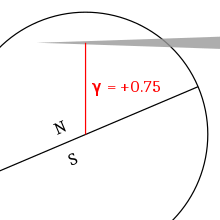Gamma value of a solar eclipse
The gamma value (symbol: γ ) of a solar eclipse describes how centrally the shadow of the moon hits the earth. The smallest distance in which the axis of the shadow cone passes the center of the earth is given as a fraction of the equatorial radius of the earth. The sign of the gamma value defines whether the shadow axis passes north or south of the center of the earth, a positive value means north.
The figure opposite illustrates the gamma value: The red line represents the smallest distance from the center of the earth, which in this figure is 75% of the radius of the earth. Since the umbra is north, the gamma value is +0.75. The fundamental plane in which this distance is measured is perpendicular to the shadow axis and contains not only the center, but also the day-night boundary (terminator) of the earth.
The magnitude of the gamma value allows different types of solar eclipses to be distinguished:
- If the amount of gamma is below 0.9972, the eclipse is central . The shadow axis meets the earth and there are places on the earth's surface, located on the so-called central line, from where an observer can see the moon passing centrally in front of the solar disk. The cause for 0.9972 instead of 1 is the flattening of the earth .
- If the amount of gamma is just above 0.9972, the axis of the shadow misses the earth, but in a polar region a non-central total or ring-shaped eclipse may be observed on the horizon. This can, essentially depending on the current distance to the moon, up to | γ | = 1.0260 happen. A large radius of the double cone in the fundamental plane is favorable for this. An example of this rare borderline case is the solar eclipse on April 29, 2014 with γ = −1.0001.
- Otherwise only a partial eclipse or no eclipse at all can be observed, with a transition area | γ | = 1.53 to 1.57.
Individual evidence
- ^ J. Meeus: Astronomical Algorithms . 2nd ed., Willmann-Bell, Richmond 2000, ISBN 0-943396-61-1 , chap. 54
- ^ J. Meeus: Mathematical Astronomy Morsels III . Willmann-Bell, Richmond 2004, ISBN 0-943396-81-6 , chap. 6th
-
↑ The radius of the penumbra of the moon is about 0.53 to 0.57 times the radius of the earth in the fundamental plane.
J. Meeus: Mathematical Astronomy, Morsels , Willmann-Bell, 2000, ISBN 0-943396-51-4 , Fig. 10.c. and
J. Meeus: Mathematical Astronomy, Morsels III , Willmann-Bell, 2004, ISBN 0-943396-81-6 , page 46
